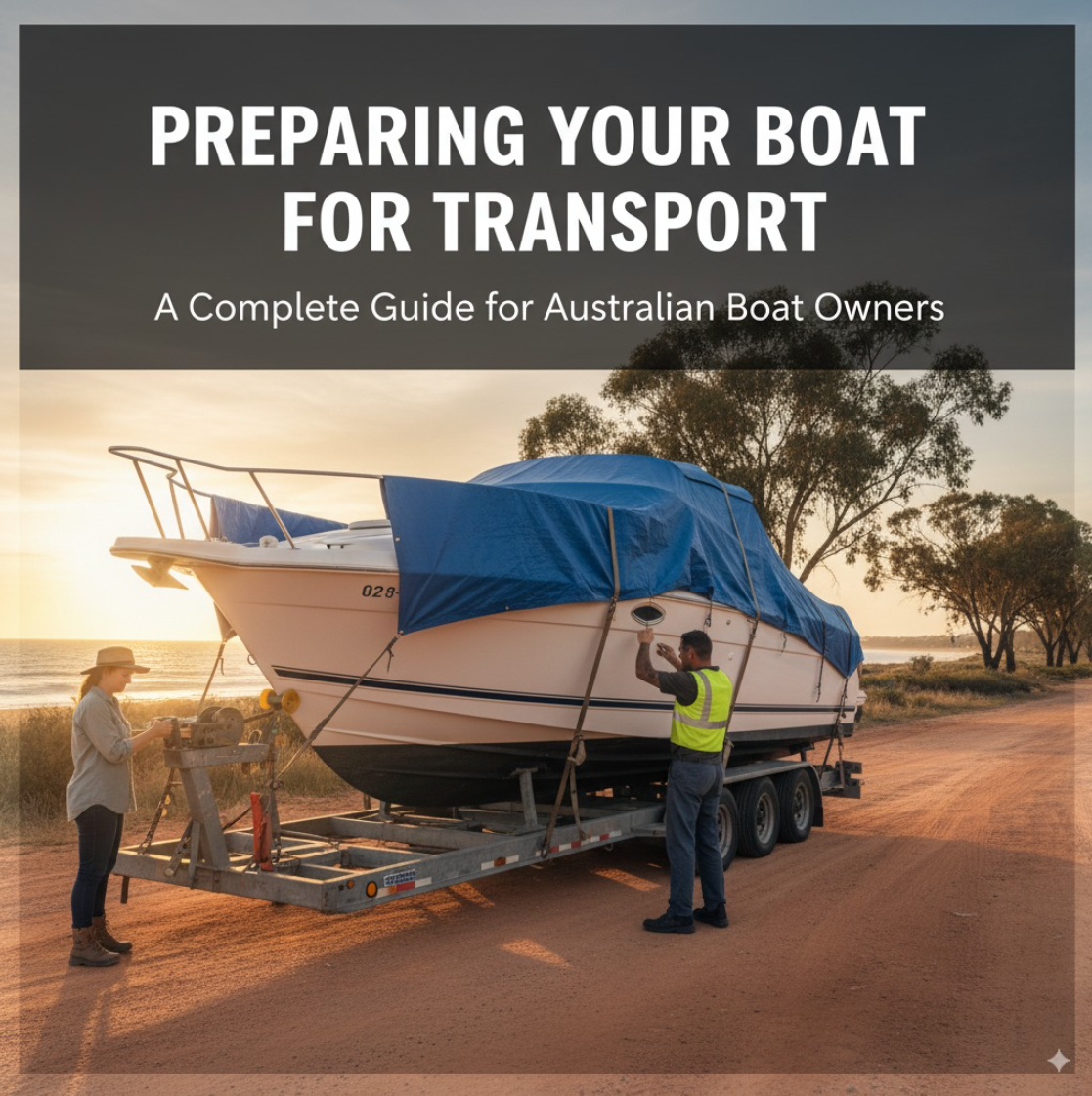Preparing Your Boat for Transport: A Complete Guide for Australian Boat Owners

4 min read
Note: This is a general approach and each carrier and service company handle things differently.
Key Takeaways
- Clean and inspect your boat thoroughly before transport, including photographs of existing conditions.
- Remove loose items and ensure fluid levels meet transport safety guidelines.
- Provide accurate dimensions and ensure the trailer (if used) is roadworthy and compliant.
- Choose a transporter that’s licensed, insured, and experienced in boat logistics.
Transporting a boat, whether across the city or interstate, requires more than simply handing over the keys. With Australia’s vast distances, variable terrain, and strict safety regulations, it’s essential to prepare your vessel properly to avoid damage, delays, or extra charges. This guide will walk you through the key steps to get your boat transport-ready, ensuring a smooth and stress-free experience from pickup to delivery.
1. Clean and Inspect the Boat Thoroughly
Start by giving your boat a comprehensive clean, both inside and out. A clean hull makes it easier to identify any existing scratches, chips, or dents that may be present before transport.
Take detailed photographs of the boat from all angles, focusing on any pre-existing damage. This will be useful for reference in the unlikely event you need to lodge a damage claim. It’s also wise to note the condition in writing and share it with your transporter for transparency.
2. Remove All Personal Belongings
Boat transport companies typically don’t cover personal items left onboard. Remove fishing gear, electronic devices, life jackets, kitchen items, and anything not securely fixed. These items can shift during transport and cause damage to the boat or themselves.
Also, detach loose fittings and accessories like:
- Antennas
- Biminis or canvas covers
- Propellers
- Depth sounders
- Trolling motors
If certain fixtures must remain onboard, make sure they’re well secured.
3. Drain Fluids and Secure Fuel
Australian boat transport guidelines recommend that boats be transported with minimal fuel in the tank, usually no more than a quarter full. This reduces the risk of leaks or fire hazards during transit. Be sure to empty water tanks and ballast tanks, drain waste water and toilet systems (if applicable), and check for any fluid leaks and repair them before the move. Proper fluid management reduces overall transport weight and helps meet safety compliance requirements.
4. Secure the Windshield and Hatch Covers
Windshields, windows, and hatch covers must be tightly secured to protect them from wind pressure, vibration, and flying debris during road transport. If your vessel includes a removable windshield or canopy, it’s advisable to remove and package it separately to prevent cracking or warping during transit.
For fixed features, use marine-grade tape or protective wrapping to cushion and secure them. Doing so reduces the risk of weather damage and ensures a smooth journey even on open trailers.
5. Prepare the Trailer (If Applicable)
If your boat is being transported on its own trailer, the trailer must be roadworthy and legally compliant. This includes:
- Tyres with adequate tread and correct inflation
- Working brake lights and indicators
- Secure winch and tie-down points
- Correct trailer registration and size compliance for road use
National Car Movers recommends getting your trailer serviced or checked by a qualified mechanic before the scheduled pickup to avoid unnecessary delays.
6. Check Dimensions and Oversize Requirements
Measure your boat’s:
- Height (on trailer or cradle)
- Width (beam)
- Length (including outboard motors, swim platforms, etc.)
If the dimensions exceed standard size regulations (usually over 2.5 m wide or 4.3 m high), your transporter may need to obtain an Oversize/Overmass (OSOM) permit through the National Heavy Vehicle Regulator (NHVR).
Providing accurate dimensions up front helps avoid compliance issues and ensures the correct transport equipment is used.
7. Communicate Clearly with Your Transport Provider
Effective communication is key to a hassle-free boat transport experience. Share the full details of your vessel, including type, size, and trailer status (if applicable), and confirm your exact pickup and drop-off addresses. It’s also helpful to inform your transporter about any site-specific access issues, such as tight driveways or remote delivery points.
Provide accurate contact information and, if you won’t be available, nominate a responsible receiver who can assist at either end of the journey. The more transparent you are from the start, the smoother the handover and delivery process will be.
Ready to Transport Your Boat?
At National Car Movers, we specialise in safe, reliable boat transport Australia-wide. Whether you’re moving a small tinny, a caravan-style trailer boat, or a large yacht hull on a cradle, we match you with licensed, insured transporters who understand what it takes to move your vessel safely. Get an instant boat transport quote or call 1300 396 099 to speak with our Australian-based logistics team.






